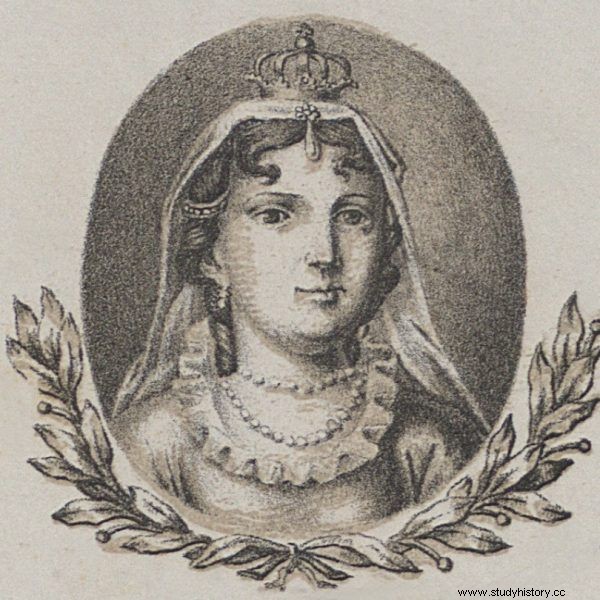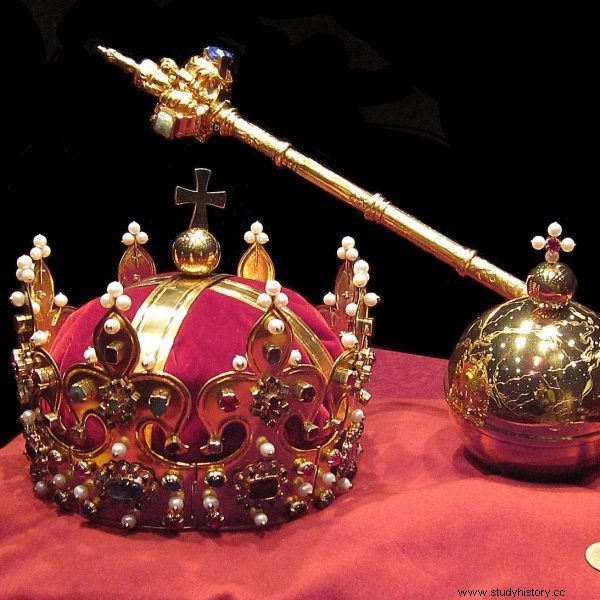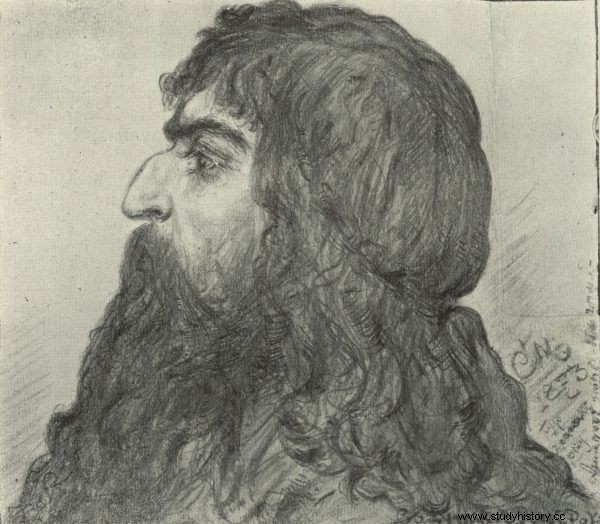Aldona Anna aroused the pity of the courtiers awaiting the birth of the prince and the disgust of the priests, who saw her as a frivolous loser. The Pope did not respect her. And the husband? After ten years of marriage, I think he only wished her death.
Jadwiga Bolesławówna - powerful and widely respected spouse of Władysław Łokietek - she probably had nothing good to say about her daughter-in-law. It is not known whether in czambuł condemned the entire relationship of the only male descendant. However, she certainly did not believe that the newly baptized, frivolous and carefree Aldona Anna had the makings of a future queen.
Marriage of the Polish successors to the throne of Kazimierz and the daughter of the Lithuanian prince Gediminas , concluded in 1325, turned out to be a political misfire. The alliance that strengthened Poland did not bring any benefits, and at the same time brought to the country and the dynasty an uninterrupted wave of accusations, innuendo and attacks from its neighbors. As if that was not enough, Aldona Anna, despite the passing years, did not bear any son to her husband.
It was on her - as the subjects and in-laws believed - that was responsible for extending the royal family. The prince's wife, however, was unable to cope with the most important task, which called into question the position and future of the Lithuanian woman.

Aldona Anna in a portrait based on the pattern of Michał Stachowicz
The last link
The distrust towards Aldona Anna was the stronger, the weaker the health of the still very young prince became. Kazimierz, who in the future will be nicknamed the Great, was fifteen at the time of his wedding, so apparently there was no reason to fear now whether he would have male offspring. Everything changed when the heir to the throne was struck by a serious illness in 1327.
The situation of the young Piast was critical. The desperate mother of the prince, Jadwiga Bolesławówna, begged for the prayerful support of the Pope himself, and at the same time entrusted her son to the special care of Saint Louis. It was her last surviving son. Kazimierz's eldest brother, Stefan, died at the age of six in 1306. The second of the group, Władysław, passed away to eternity as a baby in 1312. The youngest, Kazimierz, was the last link of the dynasty. Without him, all the effort went into the unification of the country and rebuild the institution of the kingdom would be wasted.
We know nothing about Aldona Anna's reaction to her husband's illness. The girl, however, must have been terrified. If Kazimierz had died, it would have been blamed for the fall of the ruling family. The prince managed to recover. Aldona Anna is different. Now the rapid extension of the dynasty was considered absolutely indispensable and urgent. Meanwhile, the Lithuanian woman was giving birth to ... only daughters.
There is only one queen
Aldona Anna's position was frail. She learned painfully and publicly in 1333 how little she was respected. The king of Poland, Władysław Łokietek, died in the early spring. Trials for a new coronation were immediately made. Nobody questioned the rights of 23-year-old Kazimierz to the crown and throne. Aldona Anna's rights, however, was a completely separate topic.
The widow queen, Jadwiga, openly announced that she opposed the elevation of her daughter-in-law to the royal rank. “In law, this should not be the case, because I am alive, a true crowned queen. Why shouldn't the other one be crowned in the same kingdom in my lifetime? ”She argued.

Replicas of Polish coronation insignia (photo:Gryffindor; CC ASA 3.0)
According to the eminent medievalist Janusz Bieniak, Jadwiga's resistance proves that in the times of Łokietek, Polish customs related to royal power were still taking shape. After almost two hundred years of the district breakdown, it was no longer remembered what to do after the death of the king and how to reconcile the positions of the queen-mother and queen-consort. In the ensuing chaos, Jadwiga could claim that she had the same rights as her husband. So also the exclusive right to the crown as long as he lives.
In fact, things were more confusing. Let us remember that Jadwiga knew foreign models. She was a world woman and she had to know how the presence of royal mothers and wives was reconciled by Germans and Hungarians. If, nevertheless, she protested against the coronation of Aldona Anna, it was not the manners or personal ambitions that were of key importance, but rather the dislike of the woman who was to be the new ruler.
The contempt of the pope, the insolence of the bishop
Jadwiga's resistance was broken, and Kazimierz's wife was crowned queen on April 25, 1333. However, the conflict resonated widely in Poland and abroad. It has already permanently influenced the image of Aldona Anna.

Pope John XXII in miniature from the 15th century.
The new queen aroused the pity of the courtiers, with less and less hope of the king's birth, and the disgust of the priests, who saw her as a frivolous loser, in love with games and incapable of fulfilling royal duties. Even the Pope John XXII did not respect her. When he sent his legate to Poland in 1334, it was customary to inform the local queen about it. However, he sent the letter only to old Jadwiga, "forgetting" that the current spouse of the ruler was Aldona Anna.
If Kazimierz's wife was not respected in the curia, then what else in the country. The monarch's powerlessness was finally revealed in 1337 by the bishop of Kraków, Jan Grot. In the monarch's absence, he ordered the guards to invade Wawel in order to free his man from the casemates, who had been detained for an unspecified crime.
Breaking into the residence was a grave offense not so much to the king as, above all, to the queen. Because Aldona Anna was in Wawel, and her protests and exhortations were simply ignored. The soldiers passed the queen as if they didn't recognize her authority at all, broke into the castle tower, and left the hill with the prisoner, disregarding the majesty of the monarch.

A true picture of medieval Poland. History without a powder in the new book by Kamil Janicki:"We will give the Polish empire". You can buy it at empik.com
Death Wish
Aldona Anna's prestige is in the gutter. The last blow was delivered to her by Kazimierz himself. Probably at the end of the 14th century, the king concluded an inheritance pact with his sister - the Hungarian queen, Elżbieta Łokietkówna.
Aldona Anna's insufficient fertility has become a topic of international negotiations. The issue of the queen's inability to bear a son was discussed publicly. The ruler felt ashamed, and Kazimierz officially… disinherited her daughters. He decided that if he himself died without having a son, the Polish throne would pass into the hands of Elizabeth's husband, Charles Robert of Hungary.
The only hope for the dynasty and for the king himself seemed ... the quick death of the queen. Only after her departure could Kazimierz count on a relationship with a partner who would bring the country heir to the throne. All the worst was wished for Aldona Anna. And in 1339 these wishes came true.

Casimir the Great on an unfinished sketch by Jan Matejko.
She left this world with a terrible fate
What exactly happened? It is not known. It could have been an accident where the body was battered like a rag doll caught in the teeth by a dog. It could also have been a serious disease, and the limbs became covered with pus and mucus before the woman breathed her last.
Whatever the case, the death of the queen at just over twenty-five caused a general shock. "Because she used her life excessively, she left this world with a rather significant and terrible fate," emphasized Traska, a Dominican connected with the Krakow court. Although it cannot be ruled out that he only colorized the information about Aldona Anna's death to emphasize how unsuccessful and sinful she was ...
***
One article is far too little to describe the fascinating profiles of Casimir the Great's wives. Find out more about Queen Aldona Anna and her successors in my new book: Ladies of the Polish Empire. The Women Who Built a Power " . You can buy it now in the official CiekawostekHistorycznych.pl bookstore .
Selected bibliography:
The article was based on materials collected by the author during the work on the book "Ladies of the Polish Empire. The Women Who Built a Power " . Some of these items are shown below. Full bibliography in the book.
- Dąbrowski J., Casimir the Great, the creator of the Crown of the Kingdom of Poland , Ossolineum, Krakow 1964.
- Długopolski E., Władysław Łokietek against the background of his times , Universitas, Krakow 2009.
- Jan Długosz's Annals or Chronicles of the Famous Kingdom of Poland , Fr. 9: 1300–1370, edited by Z. Kozłowska-Budkowa et al., ed. pour. D. Turkowska, M. Kowalczyk, trans. J. Mrukówna, ed. half. J. Garbacik, K. Pieradzka, PWN, Warsaw 2009.
- Jasiński K., Marriages and political connections of Kazimierz Wielki , "Studia Źródłoznawcze", vol. 32–33 (1990).
- March A., Aldona Anna [in:] Polish rulers , ed. B. Czwojdrak, M Publishing House, Krakow 2017.
- Sroka S.A., Personal life of Kazimierz Wielki. Sources and the truth [in:] Kazimierz - the Great and famous for his deeds Materials from the scientific session, Nowy Wiśnicz, 14–15 May 2010 , Historia Iagellonica, Krakow 2011.
- Śliwiński J., The marriages of Casimir the Great. A study in the field of morality and ethics of the royal court in Poland in the 14th century , Pedagogical University in Olsztyn, Olsztyn 1987.
- Wyrozumski J., Casimir the Great , Ossolineum, Wrocław 2004.
